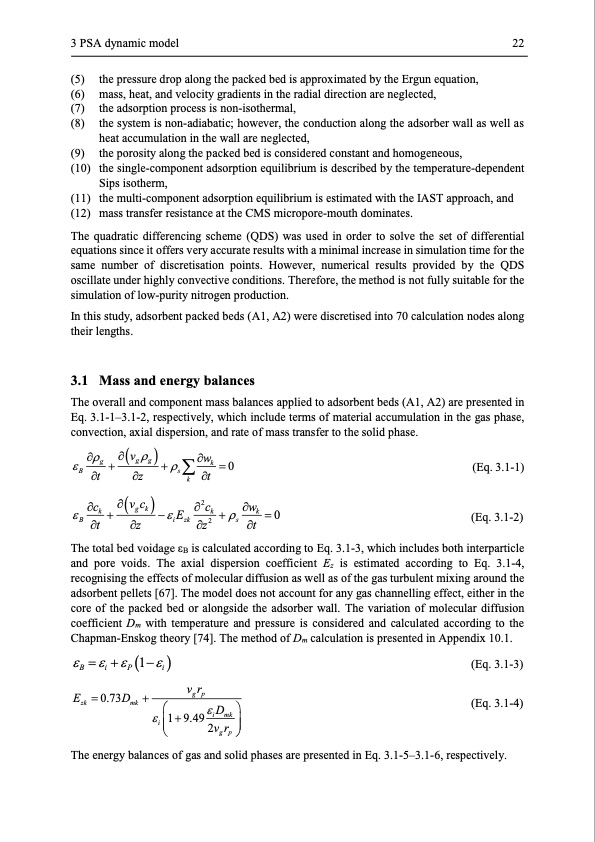
PDF Publication Title:
Text from PDF Page: 035
3 PSA dynamic model 22 (5) the pressure drop along the packed bed is approximated by the Ergun equation, (6) mass, heat, and velocity gradients in the radial direction are neglected, (7) the adsorption process is non-isothermal, (8) the system is non-adiabatic; however, the conduction along the adsorber wall as well as heat accumulation in the wall are neglected, (9) the porosity along the packed bed is considered constant and homogeneous, (10) the single-component adsorption equilibrium is described by the temperature-dependent Sips isotherm, (11) the multi-component adsorption equilibrium is estimated with the IAST approach, and (12) mass transfer resistance at the CMS micropore-mouth dominates. The quadratic differencing scheme (QDS) was used in order to solve the set of differential equations since it offers very accurate results with a minimal increase in simulation time for the same number of discretisation points. However, numerical results provided by the QDS oscillate under highly convective conditions. Therefore, the method is not fully suitable for the simulation of low-purity nitrogen production. In this study, adsorbent packed beds (A1, A2) were discretised into 70 calculation nodes along their lengths. 3.1 Mass and energy balances The overall and component mass balances applied to adsorbent beds (A1, A2) are presented in Eq. 3.1-1–3.1-2, respectively, which include terms of material accumulation in the gas phase, convection, axial dispersion, and rate of mass transfer to the solid phase. (Eq. 3.1-1) (Eq. 3.1-2) g +(vgg)+wk =0 Bt z s t k ck +(vgck)−E 2ck +wk =0 B t z i zk z2 s t The total bed voidage εB is calculated according to Eq. 3.1-3, which includes both interparticle and pore voids. The axial dispersion coefficient Ez is estimated according to Eq. 3.1-4, recognising the effects of molecular diffusion as well as of the gas turbulent mixing around the adsorbent pellets [67]. The model does not account for any gas channelling effect, either in the core of the packed bed or alongside the adsorber wall. The variation of molecular diffusion coefficient Dm with temperature and pressure is considered and calculated according to the Chapman-Enskog theory [74]. The method of Dm calculation is presented in Appendix 10.1. B =i +P(1−i) Ezk =0.73Dmk + vgrp (Eq.3.1-4) (Eq. 3.1-3) imk 1+9.49D i 2v r gp The energy balances of gas and solid phases are presented in Eq. 3.1-5–3.1-6, respectively.PDF Image | Modelling and Simulation of Twin-Bed Pressure Swing Adsorption Plants

PDF Search Title:
Modelling and Simulation of Twin-Bed Pressure Swing Adsorption PlantsOriginal File Name Searched:
dissertation_marcinek.pdfDIY PDF Search: Google It | Yahoo | Bing
CO2 Organic Rankine Cycle Experimenter Platform The supercritical CO2 phase change system is both a heat pump and organic rankine cycle which can be used for those purposes and as a supercritical extractor for advanced subcritical and supercritical extraction technology. Uses include producing nanoparticles, precious metal CO2 extraction, lithium battery recycling, and other applications... More Info
Heat Pumps CO2 ORC Heat Pump System Platform More Info
| CONTACT TEL: 608-238-6001 Email: greg@infinityturbine.com | RSS | AMP |